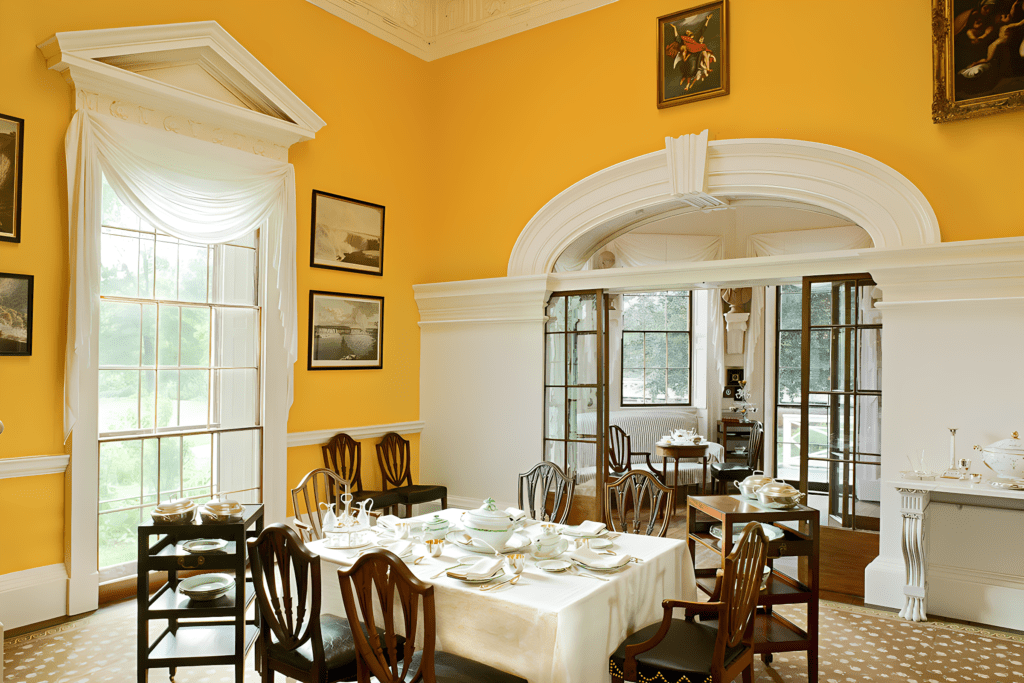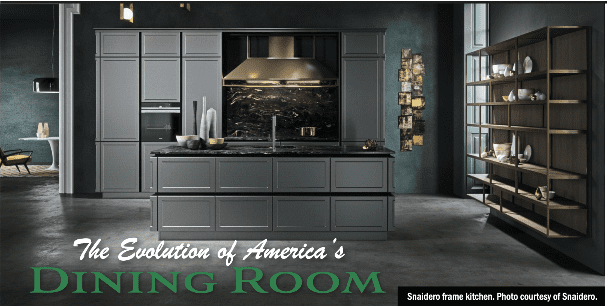At Home: The Evolution of America’s Dining Room
By • March 8, 2023 One Comment 2999


Our cover story for our March 2023 Real Estate Review print edition explores the history of America’s dining rooms.
In America, the dining room is completely dispensable. There’s really no need for a specific room in which to dine since we can just as easily eat in the kitchen or the living room on trays perched on our laps. In fact, prior to the 18th century in the American colonies few rooms had assigned functions. So, the dining room had yet to become a fixture of middle-class homes.
There was the “hall,” dominated by the fireplace, where meals were cooked and eaten. The 17th-century hall in early America was typically lit by a couple of candles and was cramped, smoky and filled with the noise and odors of daily living. In addition to the fact that specific dining rooms were not yet a thing, many 17th-century American farms were sparsely furnished, so it was difficult for families to dine together regularly, in part because there were no dining tables. During the late 1700s, families consumed most of their food from either a shared trencher — an oblong wooden dish carved out like a trench, or they ate from a long board, or pair of boards nailed together (to sit “at the board” was to eat). Many times, there were not enough chairs for all members of the family, in which cases the men would sit, and the women and children might stand. (Let’s save the fact that there were few utensils and no napkins for another column.)
As families prospered in the American colonies and gathered more possessions, the “the keeping room,” or kitchen where cooking and the heat and mess that went with it moved to a separate building, the hall became “the best room,” where guests could be entertained. Increasingly important in evolving middle-class culture, the modern dining room became a place for show and display, as well as for communal dining.
In 1772, Thomas Jefferson’s Monticello, was one of the first American homes to have a room specifically meant for dining, with the dining table at its center. It became the example of the “dining room” that began to be incorporated into wealthy homes across the country. As increased commerce brought more comforts, the middle class appropriated this changed notion of home and “dining chambers” began appearing in architectural plans.

George Washington’s dining room at Mt. Vernon. Photo courtesy Mount Vernon.
As in many of the early Georgetown houses, builders had to dig down into the earth and erect subterranean retaining walls to support the densely packed, mostly-brick houses. In the 18th century, dining rooms were typically located at the rear of the house either as a separate room or in conjunction with the front parlor. Only in 1821, did the dining room move to the front of the house in a prominent position equal to the main parlor. In many of the larger early homes in Georgetown, it was common for basements — then called cellars or caverns — to house the kitchens while allowing the front door to open directly to a dining room, library, or drawing room.
By the Victorian era, the desire to display one’s wealth was reflected in the complex rituals of dining. Giving dinner parties became an art form where the most minute details of serving and dining were observed. The social interactions in this one room could mean all the difference in one’s social position, so the dining room was appointed accordingly with all the accoutrements of wealth— a massive dining table, fine art, a fancy sideboard, walls covered in elaborate wallpaper and every surface held porcelain, silver and glass.
Finally, due to changing world dynamics, the Victorians found that work got in the way of proper dining, and they adapted their lives and meal-taking to the ringing of the factory bell, Concurrently, many of the huge and elaborate Italianate, Queen Anne Revival, Rococo Revival and Second Empire housing styles of the Victorians were seen as too contrived and less practical to manage and were followed by somewhat smaller “cottages.” And, although it was certainly a time of revivals, the three styles which are unique and original to the early twentieth century — Arts and Crafts, Art Nouveau, and Art Deco each had its own interpretation of dining room design. Although each of these styes had different aesthetics and backgrounds and arose out of different beliefs, they shared many of the same elements — good, clean lines, modern, and sleekly functional and devoid of the over-ornamentation of the prior period.
After the ravages of the Second World War, the dining room emphasized importance of a happy nuclear family. Laid upon the dining table was the idealistic expectation that all family members would be agreeable, pious and united. That romanticized notion of the dining room continued to be pressed upon Americans a la Thanksgiving by Norman Rockwell through the rest of that century.
During the 1990s, the “great room” became popular, and the open-plan concept purported to make cooking, entertaining and even parenting easier. Formal dining rooms became obsolete repositories of unread mail – the least used room in the house. But the pandemic changed that idea and the dining room – having morphed into a home office, or classroom during lockdown, got another look. We reappraised how our homes function. The pandemic gave families the experience and the freedom to use the dining room as a multi-purpose space — be it a game room, library or a traditional dining room.
The dining room has always been an evolving concept, endlessly in flux, a source of socialization. The beauty of the current dining room is whether it is used as a traditional, formal dining room or a multi-use dining room, where people actually live. It is not a stodgy museum.
Michelle Galler is a realtor with Chatel Real Estate, and represents buyers and sellers in both Rappahannock County, Virginia, and Washington, D.C. She is also an antiques dealer and columnist.


Thanks for this interesting history of the American dining room! I never thought about the room before, and will now dine with a whole new appreciation for the room I’m in.